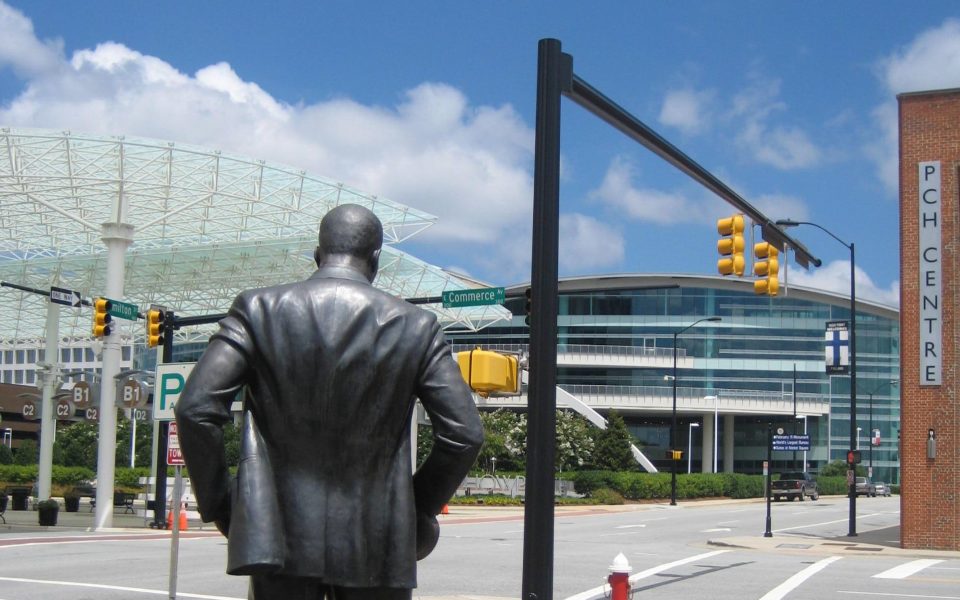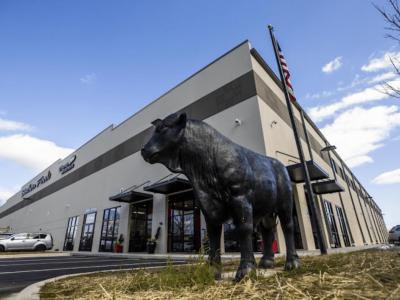Featured photo: The John Coltrane statue at High Point City Hall, with the Mendenhall Terminal (left) and Showplace exhibition building (right) in the background. (photo by John Joe Schlichtman)
The following excerpt is from Showroom City: Real Estate and Resistance in the Furniture Capital of the World by John Joe Schlichtman. While the book privileges the voice of residents, this adapted excerpt from Chapter 1 considers key ideas from the study of community that can help us to better interpret this unique place.
When the furniture market surpassed 1,000,000 square feet in the 1960s, the director of High Point’s largest building stated his goal was not national, but world prominence. The decades of investment that followed occurred without coordination or regulation. After being controlled by myriad individual firms, a transaction in 2011 resulted in private equity funds (first Bain, then Blackstone) controlling a majority of the downtown’s square footage, which now tops 12,000,000 square feet.
Today, as Part 3 of the book explores, efforts to make downtown High Point a “living room” for residents, rather than simply a stage set for marketgoers, have gained significant power. The four sections below offer terms to organize how we think of these efforts.

Chasing ‘Highest and Best Use’: Exchange Value and Use Value
“You may have heard that our Furniture Market was the last bastion of free market capitalism,” said real estate attorney Tom Terrell, talking about High Point’s ascendance in the furniture industry. “I mean, it was run by real estate interests. If you could rezone for showrooms, you did it. It was loosely organized. But, truly, it was run by real estate interests, not by the furniture companies.”
For most of its history, downtown High Point has been dominated by various configurations of what urbanists call a growth machine: shifting alliances of local stakeholders who worked to “increase aggregate rents . . . for those in the right position to benefit.”1 This arrangement not only normalizes the celebration of elite growth goals as an assumed facet of civic life but also places localities in competition with one another in a way that actually harms their citizens.
Although leaders in a growth machine do not always agree on the best strategies and specifics of growth, they do agree that what we call exchange value—the monetary value of property determined by sale in an open market—should be at the core of what the local government does and the local community celebrates. In this way, High Point’s growth machine helped determine how local political, economic, and social life interacted with the world around it. Observing their actions illuminates the links that connect “daily life and mundane local politics” with economic and political systems that shape and are shaped by these politics.
The growth machine’s pursuit of exchange value can come into conflict with residents’ concern for use value, the worth derived from the satisfaction of using a property. The more land becomes a commodity and the less its use value is debated in relation to its exchange value, the more its land markets will be an unabated free market.
Terrell’s words are shocking: not only did the growth of the Market ignore residents’ interests, but it also sidelined the interests of the furniture exposition it was presumably serving. That is, a Market centered on excellent furniture exposition would have been designed differently. Instead the unguided High Point Market became a huge, chaotic, global furniture bazaar.
“The Market itself has challenges in that it is not under single ownership control,” High Point planning director G. Lee Burnette—who recently retired—explained. That allows each individual building to “decide when to turn the lights on and when to turn the lights off . . . Here, it truly is a market—small ‘m’—phenomenon.” In some other southern cities, “citizens expect and demand” regulation, whereas High Point is “more of a free market, this-is-my-property-I-can-do-anything-I-want-to-with-it type approach,” he said. Some residents call it cowboy capitalism and academics may call it neoliberal governance.
Whatever the perspective, few municipal governments have enshrined exchange value to the extent that High Point’s city council has over the past six decades, and, correspondingly, few have witnessed such a radical transformation. “To some degree, you can argue that not having any regulation on it has allowed it to evolve and be here for one hundred–plus years,” Burnette added.
Politician Judy Mendenhall has been a key player throughout this process. When I first met Mendenhall, she was the inaugural president of the High Point Market Authority. Serving as mayor earlier in her political career, she was known for walking the downtown in tailored business attire and running shoes. To many, she exemplified casual southern sophistication. “I don’t think it’s the southern way to have a Plan B,” she said from her Market Authority office in downtown High Point’s brutalist white office building—often simply called “the white building” because its name changed so often as flagship tenants moved in and out. This was the first of many “No Plan B” conversations.
In an unimpeded growth machine, owners are free to “manipulate property to ‘highest and best use’ by market criteria,” as sociologist Harvey Molotch explains. Not developing a Plan B and pursuing what real estate parlance calls highest and best use were complementary if not virtually synonymous. Throughout the Market’s history, High Point leaders invoked the tenets of highest and best use to justify their pro-growth strategies, privileging development that is “physically possible, appropriately supported, financially feasible, and that results in the highest value.” As Part 3 of the book explores, attempts at community discussions about the long term effects of this growth were scoffed at, even when these calls for reflection were by powerful city leaders.

The Tension Between Economic and Life Space
As the city’s downtown stakeholders pursued highest and best use, the downtown became what urban planning thinker John Friedmann calls economic space. Driven by calculations of exchange value, economic space seems endlessly expandable with little concern as to context. Similar to the ‘enterprise zones’ that have emerged worldwide in the era of globalization, High Point’s local government eliminated for downtown showrooms the red tape that developers would experience elsewhere in the city. As Part 1 of Showroom City explores, the more High Point became wedded to the Market, the more local government leaders felt that they had to cede control to real estate investors to avoid losing the Market to a competitor. Unlike its company-town kin, also controlled by a single interest, High Point leaders had no representative with whom they could meaningfully discuss and negotiate. There was no single convention complex that managed these tenants. Rather, a plurality of owners and building tenants acting independently made up the High Point Market.
The control given to showroom interests has meant that High Point is remarkably nimble when it comes to the Market. Local officials are proud of how quickly developers erected major downtown projects, even when national, state, regional, and local bureaucracies were involved. They point to how the city quickly settled disputes between landowners or even between the city and exhibitors. The city has allowed showroom buildings in violation of fire and building codes to remain open for the Market, arguing in that instance that the government must “assist as much as we can to make each Market successful.” Such loosening of government control is evidence of urban planning thinker Edward Soja’s “erosion of local control over the planning process, as the powerful exogenous demands . . . penetrate deeply into local decision-making.”
Burnette agrees. “Certainly our position in the furniture industry influences our policy,” he said. “The city has had a laissez-faire approach to Market.” But for local, nonshowroom business owners who have not enjoyed access to such expedited processes, the opposite is true. Like the many zones considered an “unregulated market,” the downtown represents not merely the absence of regulations considered hindering but the marked presence of regulations favoring particular outcomes and effectively prohibiting others. As longtime students of municipal government know, one stakeholder’s “let it be” environment often results in another stakeholder’s “don’t let it be” situation. It may sound strange, but deregulation requires regulation so that market freedoms produce the outcome its champions desire. Or so that sovereignty is “sovereign in the right way.”
In High Point, until only recently, the right free market has meant that the downtown would be shorn of locals. It has seen property owners and showroom operators frequently oppose the return of a resident-centered aspect to the downtown. Over the Market’s history, they have favored suspending the use of buildings—and thus the entire downtown—between Markets to cut their costs and preserve their assets. In the words of architectural critic Ada Louise Huxtable, government used its power of zoning as “an instrument for maximizing real estate return” for investors rather than making the “city a fit place to live” for residents.
“Realtors don’t bother to even take people downtown anymore because they say you’re wasting your time. The rents are too high,” politician Jay Wagner explained—before becoming a mayor who led efforts to change this. “If a property owner from a purely economic standpoint can rent the building for four weeks a year and have no wear and tear on their building and can make lots of money doing that, why wouldn’t they do it? I understand simple economics.”
But residents’ biographies unfold in life space, as Friedmann explains. And this can present frustrating impediments to stakeholders in economic space seeking unimpeded growth. In life space, residents’ and their lives, struggles, and aspirations are forged: this is “the theater of . . . convivial life.” High Point’s “complete dedication” to furniture exposition, as one Market official described it, did little for High Point’s life spaces. When urbanists discuss control by capital, they often mean securing the cheapest labor or the most efficient distribution of their goods. Downtown High Point is a little different. Local leaders have allowed exhibition building owners what they sought most: a particular grip on the downtown’s time and space.

Exclusion, the Frontstage, and the Backstage
“Why is it that once you leave the showroom area of downtown, High Point looks like a slum?” a former resident asked in a letter in 2000 to the High Point Enterprise. “Why do the leaders place so much emphasis on this one area of the city when so much of the city needs help?” he continued. “The leaders of High Point need to wake up . . . and start treating the citizens as something other than second-class people.”
Concern has grown over the past four to five decades that leaders around the world are increasingly fixated on using their cities as if they were a stage for productions for outsiders, whether gentrifiers, investors, tourists, or business visitors. This can produce two different types of boundaries that exclude: a geographic boundary that marks where the privileged stages are and are not, and a temporal or time-based boundary concerning when those privileged stages are and are not under the spotlight.
I use the term frontstage to refer to a place that is a privileged geography during the time when the production is in process. Backstage refers to both the times in the frontstage when the production is not “on” and the places that are never in the frontstage. What transforms the dynamics of these terms? The gaze of an outside audience. In High Point, this gaze by more than 70,000 visitors from over 100 nations increasingly compares “everywhere in the world . . . with everywhere else,” as sociologist John Urry has observed.
There is a term in theatre called mise-en-scène that implies both concepts: frontstage and backstage. It describes everything the audience sees on the stage during a performance, including the arrangement of the actors, the props, costumes, and settings. Historically, a preoccupation with High Point’s frontstage mise-en-scène has completely dominated downtown High Point during the backstage months. This is a unique type of control over the urban landscape: control of its temporality—its relationship to time.
Urban temporality is not unique to High Point. Every city has a temporality—times when it is “on” and times when it is “off” to particular audiences. Historians E. P. Thompson and Tamara Hareven describe how just such a reorganization of time accompanied the advent of industrial life. Manufacturing cities had typically pulsed around the shifts of the local factory; their taverns and diners adjusted to match their workers’ daily schedules. College towns are often ghost towns in June and July when they are in their backstage months. Come graduation, local hotels, apartment buildings, and even municipal services adjust their cycles; bushes are trimmed and even curbs get a fresh coat of paint. Major service-center cities also have their temporality, assuming an air of commerce during business hours with stints of lively street-level activity around lunch and perhaps evening times. Some residents lament that their city’s business district is not “alive after five.” Each of these cities may have influxes of outsiders, but their rhythm is still driven largely by their residents and daily commuters.
Most cities are similar. Certain scenes replay daily: during rush, work, and after-work hours. Even the dissimilar industrial and postindustrial eras share what sociologist Eviatar Zerubavel calls the “highly regular temporal structuring” that allows an observer to “tell the time by simply referring to the social environment.” Both industrial and postindustrial cities operate on a visible cycle of weekdays and weekends, providing a “seven day beat.”
Downtown High Point operates differently: here the month most structures events. Observation alone cannot distinguish a Wednesday from a Sunday or ten in the morning from eight in the evening. This temporality became evident when I tried to create a year-by-year timeline of the downtown’s rhythms with showroom designer Callie Everitt, who wracked her brain before confessing how difficult it was for her to translate the six-month rhythm of her life into my calendar of weeks, months, and years. “I think in Markets,” she apologized.
Before deindustrialization hit the city in the 1970s, the ideas of either a geographic or a temporal frontstage were less meaningful in High Point, where production and exhibition of furniture were then inextricable. However, in the era of globalization, the city’s service-industry and manufacturing-industry fortunes began diverging. City and Market officials reprioritized and deprioritized particular regions and times based on the exposition. The downtown transitioned from being the main commercial district of a vertically integrated manufacturing town to the runway for furniture’s fashion week. At the same time, the area around the red carpet was crumbling.

The Tension Between Prime Space and Marginal Space
The use of terms such as downtown and slum, both used above, is important here. These terms evoke a segregated city with spaces of lack and plenty, municipal negligence and priority. Capitalizing on middle-class fears of what lies within the slum or ghetto spaces, developers build fortified enclaves in the downtown with designs that enclose and isolate buildings from the street. Such fears were prevalent in High Point. The result is a “citadel” or, in São Paulo, what urban planning scholar Teresa Caldeira called a “city of walls.”
These ideas can be subsumed under two useful terms: prime and marginal space. Prime space is that desired “for residential, commercial, recreational, or navigational purposes.” Consider developing world cities where international investment has enabled particular favored neighborhoods—deemed prime space—to grow very rapidly, fostering the development of globally integrated office, retail, and residential enclaves. Meanwhile, the remainder of the city, unhinged from these flows of investment, is left to carve out a life on the city’s margins. This marginal space has little exchange value and includes places where marginalized people such as homeless or poor residents, as well as marginalized uses such as informal settlements or single-room occupancy hotels, have more flexibility. These locations are peripheral, uncontested, and out of view. In marginal spaces, as urban planner and architect Andrés Duany noted, city inspectors only sporadically and selectively show up to monitor compliance with local ordinances.
High Point’s marginal spaces form a periphery around its prime space. Sociologist Stephen Sills and his team from the University of North Carolina at Greensboro identified more than 1,400 acres of vacant housing in the neighborhoods surrounding the downtown. These census tracts had poverty rates of 32 to 87 percent, and the vast majority had labor force nonparticipation rates greater than 40 percent. City leaders refer to this area beyond the downtown as the “urban core.” It consists of neighborhoods “plagued with blighted empty lots, vacant buildings, substandard housing, and whose residents have long experienced a lack of opportunity.” The ring of decay is interrupted at points, most prominently by Emerywood, the city’s old-money neighborhood northeast of the downtown.
This southern landscape of bungalows, two-by-fours, shotguns, and low-rise public housing stands witness to the drastic devaluation over time brought on by mortgage redlining, federal defunding, municipal deprioritization, and physical deterioration, most strikingly in Black neighborhoods. “It was really eye-opening to see how many houses are boarded up and that are vacant in town,” began one civic leader discussing a 2012 tour with other leaders: “I had never seen that.” Today, cities of various sizes include vast areas of unoccupied and unused blocks that are invisible to residents with no connections there.
Gentrification gets most of the attention, but this is the other landscape of displacement: discarded neighborhoods. Although located just blocks from the frontstage, they are what urban sociologist Saskia Sassen calls unhinged: from the global economy, the commerce of the downtown, and the mental map of most visitors and many residents. What creates unprecedented inequality is the fact that these unhinged areas can remain stubbornly disconnected from the global economy even as nearby areas become ever more connected. “It’s awful. All the boarded-up buildings, all the houses that no one can live in,” said High Point nonprofit leader Maggie Mays. “But, you know, the only thing that matters is the showrooms that are open four weeks a year.”
“There’s a lot of job opportunities when the Market is here—and that’s very beneficial for their families,” explained community college administrator Janette McNeill just before change began to bubble to the surface, discussing prospects for students within the local economy. “But as a community we need to look at it a different way because that just keeps people in poverty.” Today, High Point as a community is looking at it a different way, with its path as a city still to be decided.
Credit: Excerpted from Showroom City: Real Estate and Resistance in the Furniture Capital of the World by John Joe Schlichtman. Published by the University of Minnesota Press. Copyright 2022 by the Regents of the University of Minnesota. All rights reserved.
Author bio: John Joe Schlichtman is associate professor of sociology at DePaul University. He is the author of Showroom City: Real Estate and Resistance in the Furniture Capital of the World, and coauthor of Gentrifier.
Join the First Amendment Society, a membership that goes directly to funding TCB‘s newsroom.
We believe that reporting can save the world.
The TCB First Amendment Society recognizes the vital role of a free, unfettered press with a bundling of local experiences designed to build community, and unique engagements with our newsroom that will help you understand, and shape, local journalism’s critical role in uplifting the people in our cities.
All revenue goes directly into the newsroom as reporters’ salaries and freelance commissions.





Leave a Reply